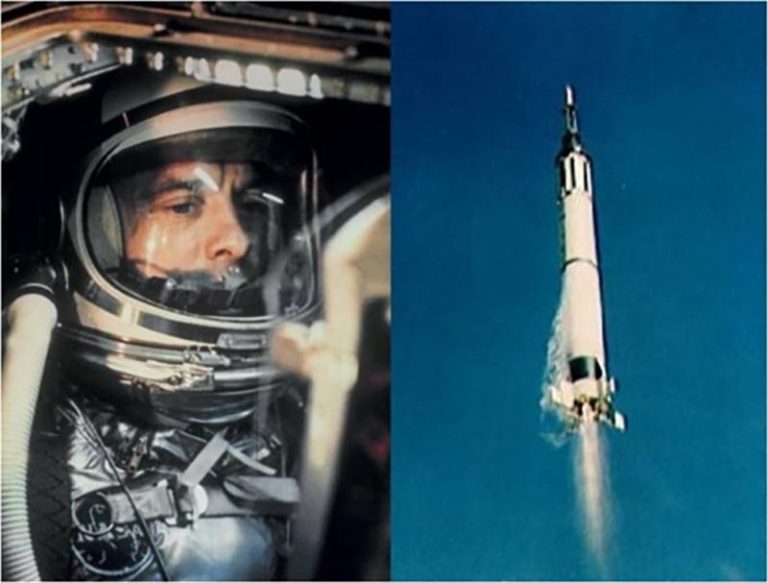60 YEARS AGO, ALAN SHEPARD WENT TO SPACE

“Why not fix your little problem by lighting this candle?”
The United States was at a standstill on May 5, 1961. Philadelphia’s judge stopped all court proceedings. People in Times Square danced and sang, while California traffic slowed down to a crawl. The White House was silent as President John F. Kennedy stared at a television picture and his hands were deep in his pockets. This was 60 years ago today, when America sent its first astronaut into space. It caused a collective sigh of relief from the nation.
The man in question was 37-year old Alan Shepard. He was a gruff New Englander, and the son of a wealthy military family. The U.S. Navy selected Shepard because of his adventurous spirit, keen wit and determination to be the best.
RUSSIA RECEIVES FIRST
Shepard was chosen in 1959 to be one of NASA’s “Mercury Seven” original astronauts. His thirst for pushing boundaries would eventually take him to the Moon. His greatest achievement was, however, being America’s first astronaut. Shepard once stated, “Not because of fame or the recognition, but because America’s top test pilots went through the selection process, down seven guys and I was the one that got to go.”
Shepard hugged his wife Louise Shepard after learning about his role in early 1961 and said that he was his first spaceman. He was surprised at her response. “Who allowed a Russian to enter here?” She laughed and jibed. She was aware that the Soviets had launched the first artificial satellite and Sputnik. Put dogs in orbit, and sent probes to the Moon. It was obvious that sending a man into space was next on their agenda.
Louise Shepard’s casual remark was a bit too much. On April 12, 1961, Yuri Gagarin made the first human spaceflight. He rode Vostok 1, around the globe, and gained instant international fame. Yet another opportunity for the United States to be first had been missed.
SHEPARD PREPARES FOR SPACE
Shepard, in the pre-dawn darkness on May 5, climbed aboard the Freedom 7 capsule at Cape Canaveral’s Pad 5. He knew it would be a slow process to catch the Russians. Redstone’s rocket, which is 83 feet tall (25 meters) and a descendant of Nazi Germany’s V-2 missile, was not strong enough to reach orbit like Vostok 1. It would instead carry Shepard’s capsule only 116 miles (188km) into space, before it splashed down in the Atlantic Ocean 15 minutes later.
Shepard was not blessed with good fortune that day. The launch was delayed by clouds that rolled over Florida’s eastern coast. A troublesome power inverter and an unexpected computer glitch also threatened to slow down the launch.
Shepard finally felt the call of nature after three hours lying down on his back for three hours. “Man, I gotta pee,” Shepard radioed. The need to go to the toilet was completely unexpected, even though there was only a 15-minute flight.
Shepard was forced to use his pressure suit to relieve himself. To prevent him from short-circuiting the thermometers or medical wiring, the spacecraft’s power was shut off. Shepard’s cotton underwear and Freedom 7’s pure oxygen atmosphere absorbed this result. Neal Thompson, Shepard’s biographer, said that the first American astronaut was spared from being electrocuted by his urine.
SHEPARD GOES TO SPACE
Shepard heard the launch command at 9:34 AM EST. With 45 million Americans listening or watching, he instinctively reached for his mission timer and lit up the engine with 78,000 pounds (35,000 kgs) of thrust. Although the liftoff was less than he expected, Shepard’s heart rate rose from 80 to 126 beats a minute.
The rocket’s engine stopped firing two minutes after launch. This resulted in an ethereal silence inside the capsule. Shepard flew free from the Redstone and had just a few minutes to test Freedom 7’s systems. He twirled his ship through pitch, roll, and yaw axes while traveling at 5,000 mph (8,000 km/h), more than three times faster that any American ever.
Shepard was able to see the Everglades’ northernmost tip through the capsule’s scope. He also saw Andros Island off Bimini and the cloud-covered Bahamas. He exclaimed, “What a stunning view,” to no one.
Shepard returned to Earth with 11 times the force of terrestrial gravitation. He was unable to communicate for a short time with only guttural grunts. Freedom 7’s drogue parachut deployed four miles (6.4 km) above the Atlantic. The main canopy, orange-and-white, was also deployed.
Shepard and Freedom 7 splashed into the air within sight of U.S.S.A. Lake Champlain. The ship’s deck was filled with hundreds of sailors who applauded America’s new hero, a hero whose unique achievement set the United States on a path to space exploration that continues to this day.
